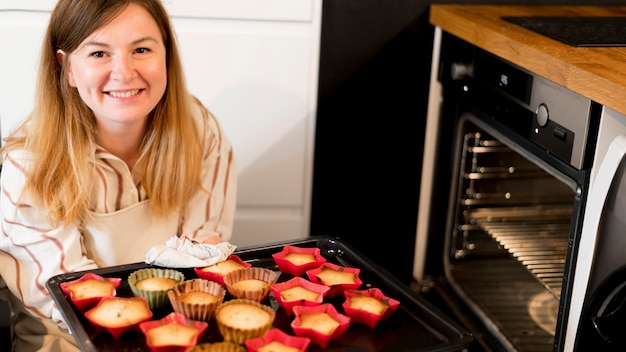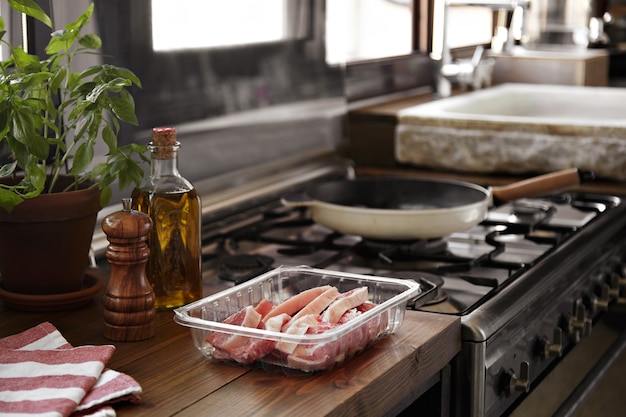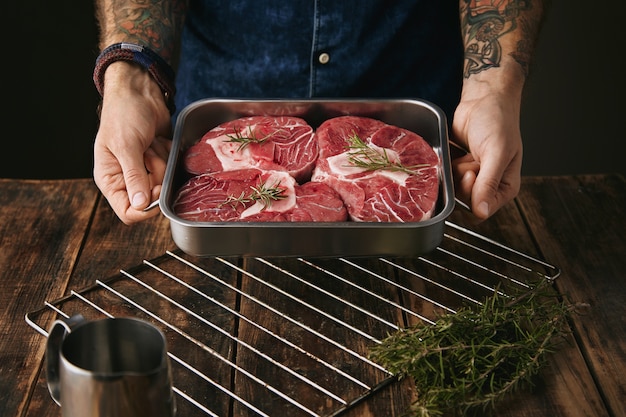As a seasoned home cook, I’ve spent countless hours experimenting with different cooking techniques to achieve that perfect steak. From searing in a hot pan to grilling over charcoal, I've tried it all. But there's something about the oven that draws me in – the gentle, even heat that allows you to cook a steak to absolute perfection. It's the method I rely on when I want to create a truly memorable meal. The oven provides a consistent and predictable cooking environment, making it ideal for achieving consistently great results.
But let's be honest, oven-cooked steak can be a bit of a mystery. Everyone's got their own preferred temperature and cooking time, and it can be hard to know where to start. Over the years, I've learned a few things about the best oven temperature for perfectly cooked steak, and I'm excited to share my insights with you.
(Part 1) The Science Behind Oven Cooking

To truly understand the best oven temperature, we need to understand the science behind it. Cooking a steak in the oven is all about managing heat transfer, and there are a few key factors to consider:
The Maillard Reaction: Unveiling Flavor
The Maillard reaction is a complex chemical process that happens when sugars and amino acids in the meat react with heat, creating hundreds of flavour compounds. It's the magic that gives steak that beautiful, crispy brown crust and rich, savory aroma. The higher the temperature, the faster the Maillard reaction happens, leading to a more pronounced browning and richer flavour. However, excessive heat can lead to burning, so finding the sweet spot is crucial.
Protein Denaturation: From Tender to Tough
Heat also denatures proteins in the steak, causing them to change shape and become more firm. This process is what makes the steak cook, but too much heat can lead to dryness and toughness. The goal is to find the sweet spot where the protein denatures just enough to create a juicy, tender steak.
Heat Transfer: Convection and Even Cooking
The oven heats the steak through convection – the movement of hot air. The hotter the oven, the faster the heat transfer. This is why a high oven temperature is ideal for creating a crispy exterior while cooking the steak through to the desired level of doneness. However, too high of a temperature can lead to uneven cooking, with the outside becoming burnt before the inside is cooked through.
(Part 2) The Best Oven Temperature for a Perfect Steak

After years of experimentation, I've found that the best oven temperature for cooking a steak to perfection is 400°F (200°C). Here's why:
- Creates a Beautiful Crust: This temperature is high enough to initiate the Maillard reaction, giving the steak that delicious crust we all crave without burning it. The heat is sufficient to create a flavorful sear without overcooking the exterior.
- Ensures Even Cooking: The hot air in the oven circulates evenly, ensuring that the steak cooks through without any hot spots. This consistent heat distribution is crucial for achieving even doneness throughout the steak.
- Maintains Juiciness: The moderate heat allows for a gentle cooking process, helping to retain the steak's natural juices. This temperature helps prevent the steak from drying out, ensuring a juicy and flavorful result.
(Part 3) Finding Your Ideal Temperature: Tailoring to Your Steak and Preferences

While 400°F (200°C) is a great starting point, the ideal oven temperature will ultimately depend on the thickness of your steak and your desired level of doneness. Here's a quick guide to help you fine-tune your temperature:
Steak Thickness: A Guide for Even Cooking
- Thin Steaks (Less than 1 inch): You can cook these at a slightly lower temperature, around 375°F (190°C). This will help prevent overcooking. Thin steaks require less time to cook through, so a slightly lower temperature helps prevent them from becoming dry and tough.
- Thick Steaks (1-2 inches): The recommended 400°F (200°C) works well for thick steaks, ensuring they cook through without drying out. The higher temperature helps ensure the inside of the steak cooks through evenly while the outside develops a nice crust.
- Very Thick Steaks (Over 2 inches): For very thick steaks, you might want to consider a slightly lower temperature, like 350°F (175°C), to give the meat time to cook evenly. This ensures that the entire steak reaches your desired doneness without the exterior burning before the center is cooked.
Desired Doneness: Finding Your Perfect Steak
The desired level of doneness will also influence the oven temperature:
| Doneness | internal temperature | Oven Temperature (Recommended) |
|---|---|---|
| Rare | 125°F (52°C) | 400°F (200°C) |
| Medium-Rare | 135°F (57°C) | 400°F (200°C) |
| Medium | 145°F (63°C) | 400°F (200°C) |
| Medium-Well | 155°F (68°C) | 375°F (190°C) |
| Well-Done | 165°F (74°C) | 350°F (175°C) |
Remember, these are just general guidelines. The best way to determine the ideal temperature for your steak is to experiment and find what you like best.
(Part 4) Oven-cooking tips and Tricks: Mastering the Technique
Now that we've covered the basics of oven temperature, let's delve into some practical tips and tricks for achieving the perfect oven-cooked steak:
Seasoning: Enhancing Flavor and Tenderness
- Salt: Salt your steak liberally about 30 minutes before cooking. This allows the salt to draw out moisture and then reabsorb it, resulting in a more flavorful and tender steak. This process helps break down the muscle fibers, making the meat more tender and flavorful.
- Pepper: Freshly ground black pepper adds a lovely kick to the steak. Add it just before cooking so it doesn't burn in the oven. Freshly ground pepper retains its flavor and aroma better than pre-ground pepper, enhancing the steak's flavor.
- Herbs and Spices: Feel free to experiment with your favorite herbs and spices. Garlic powder, onion powder, paprika, and rosemary are all great options. Experimenting with different flavor profiles can elevate your steak to new heights.
Resting: Unlocking Juiciness
Resting is crucial for allowing the juices to redistribute throughout the steak, resulting in a more tender and flavorful cut. Rest your steak for at least 10 minutes before slicing and serving. This allows the meat to relax, and the juices to reabsorb, ensuring a more flavorful and juicy steak.
Searing: Achieving a Crispy Crust
For a truly irresistible steak, consider searing it in a hot pan before finishing it in the oven. This will create a beautiful crust and enhance the flavor. Searing the steak before oven cooking gives it a delicious crust and intensifies the Maillard reaction, resulting in a more flavorful and appealing steak.
Doneness Check: Combining Touch and Thermometer
Don't rely solely on a meat thermometer to determine doneness. Use the touch test as well:
- Rare: Soft and springy
- Medium-Rare: Soft and slightly firm
- Medium: Firm and springy
- Medium-Well: Firm and slightly hard
- Well-Done: Hard and firm
The touch test can give you a quick indication of the steak's doneness, but a meat thermometer is essential for ensuring accuracy, especially if you're aiming for a specific internal temperature.
(Part 5) My Go-To oven steak Recipe: Simple and Flavorful
Over the years, I've developed a simple but foolproof oven-cooked steak recipe that consistently produces tender, flavorful results. Here's how I do it:
Ingredients:
- 1 (1-inch thick) new york strip Steak (or your favorite cut)
- 1 tablespoon olive oil
- 1 teaspoon salt
- 1/2 teaspoon freshly ground black pepper
- 1 clove garlic, minced (optional)
- Fresh herbs (rosemary, thyme, parsley, etc.) (optional)
Instructions:
- Preheat the oven to 400°F (200°C). Preheating the oven ensures that the steak cooks evenly and efficiently.
- Pat the steak dry with paper towels and season generously with salt, pepper, and any additional herbs or spices. Patting the steak dry helps to create a better sear and prevents the meat from steaming in the oven, resulting in a more flavorful crust.
- Heat the olive oil in a large oven-safe skillet over medium-high heat. Using an oven-safe skillet allows you to sear the steak and then transfer it directly to the oven for easy cooking.
- Sear the steak for 2-3 minutes per side, until nicely browned. Searing the steak creates a delicious crust and intensifies the flavor.
- Transfer the skillet to the preheated oven and cook for 5-7 minutes for medium-rare doneness, adjusting the cooking time based on the desired level of doneness. The cooking time will vary depending on the thickness of the steak and your preferred doneness.
- Remove the steak from the oven and let it rest for 10 minutes before slicing and serving. Resting the steak allows the juices to redistribute throughout the meat, resulting in a more tender and flavorful steak.
This recipe provides a simple and straightforward approach to oven-cooked steak, but feel free to customize it to your liking. Experiment with different cuts of meat, marinades, and seasonings to find your perfect steak.
(Part 6) Oven Steak Alternatives: Expanding Your Cooking Horizons
While oven-cooked steak is a classic, there are other ways to enjoy this delicious cut of meat in the oven, offering unique flavors and textures.
reverse searing: Tenderness and Crust Combined
Reverse searing involves cooking the steak at a low temperature (250°F - 275°F) for a longer period of time before finishing it off with a quick sear in a hot pan. This method results in a perfectly cooked steak that is incredibly juicy and tender. You can achieve similar results in the oven by setting the temperature to 250°F (120°C) and cooking for 45 minutes to an hour before finishing it at 400°F (200°C) for a few minutes to create a crust. This technique ensures even cooking and a perfectly tender interior while achieving a flavorful crust.
Sous Vide: Precision and Control
sous vide cooking involves sealing the steak in a vacuum bag and immersing it in a water bath at a precise temperature. This method ensures perfectly even cooking and allows you to control the doneness with incredible accuracy. While sous vide requires a special water bath, it's a great option for achieving restaurant-quality results at home. It's ideal for those who want a consistent and controlled cooking method.
Roasting: Perfect for Larger Cuts
For a larger cut of meat, like a ribeye roast or a standing rib roast, roasting in the oven is the way to go. Simply season the roast liberally with salt, pepper, and any other desired spices, and roast it in the oven at 325°F (160°C) for 2-3 hours, or until the internal temperature reaches 135°F (57°C) for medium-rare. This method ensures the meat cooks evenly and retains its moisture, resulting in a flavorful and juicy roast.
(Part 7) Oven Steak Variations: Adding Flavor and Creativity
There are endless variations you can try with your oven-cooked steak, adding exciting flavor profiles and textures to your meals.
Marinades: Infusing Flavor and Tenderness
Marinades add incredible flavor and tenderness to your steak. Popular marinade ingredients include soy sauce, lemon juice, olive oil, garlic, ginger, and herbs. These ingredients help to break down the muscle fibers, making the meat more tender and flavorful. They can also add a unique dimension to your steak's flavor profile.
Glazes: Adding Shine and Sweetness
Glazes can transform your steak into a culinary masterpiece. Popular glazes include honey mustard, barbecue sauce, and balsamic glaze. These glazes add a beautiful shine and a touch of sweetness to the steak, enhancing its flavor and visual appeal.
Toppings: Adding Texture and Complexity
Toppings add a final touch of flavor and texture to your steak. Popular toppings include blue cheese, caramelized onions, sauteed mushrooms, and a drizzle of truffle oil. Toppings offer a final flourish of flavor and texture, completing the steak experience.
(Part 8) FAQs: Answering Your Steak Questions
Here are some common questions about oven-cooked steak, answered:
Q: Can I use a broiler to cook steak?
A: Yes, you can use a broiler to cook steak. The broiler will create a crispy crust and a juicy interior, but it's important to watch the steak closely to avoid overcooking. The broiler is a great option for quickly searing the steak and achieving a crispy crust, but it's crucial to monitor the cooking process closely to prevent overcooking.
Q: How long should I cook a steak in the oven for?
A: The cooking time for a steak in the oven will vary depending on the thickness of the steak, the desired level of doneness, and the oven temperature. It's best to use a meat thermometer to ensure the steak is cooked to your liking. A general guideline is to cook a 1-inch thick steak for 5-7 minutes per side for medium-rare.
Q: What are some good sides to serve with oven-cooked steak?
A: Oven-cooked steak pairs well with a variety of sides, such as roasted vegetables, mashed potatoes, asparagus, creamed spinach, and a simple salad. Choosing sides that complement the flavors of the steak can create a well-balanced and delicious meal.
Q: Can I cook multiple steaks in the oven at once?
A: Yes, you can cook multiple steaks in the oven at once, but make sure to give them enough space to cook evenly. If your oven is crowded, the steaks may not cook evenly and could end up overcooked. Ensure that the steaks are not touching each other to allow for proper heat circulation and even cooking.
Q: How do I prevent my steak from drying out in the oven?
A: To prevent your steak from drying out in the oven, ensure it's properly seasoned and cooked at a moderate temperature. A meat thermometer is essential for checking the internal temperature of the steak to ensure it's cooked to your liking without overcooking. Using a meat thermometer is a crucial tool for preventing overcooking and ensuring a juicy and flavorful steak.
I hope this article has helped you master the art of oven-cooked steak. Remember, the key to success is finding the right temperature for your steak and desired doneness, using quality ingredients, and embracing experimentation. With a little practice, you'll be creating mouthwatering steaks that will impress your friends and family.
Now go forth and experiment with your oven temperatures and techniques to discover your perfect oven-cooked steak. Happy cooking!
Everyone is watching

Corn on the Cob: The Ultimate Guide to Perfectly Cooked Ears
Healthy MealsAh, corn on the cob. Just the name evokes images of sunny days, barbecues, and that sweet, juicy flavour that ...

Perfect Pork Roast Oven Cooking Time: A Guide to Delicious Results
Healthy MealsThere's something truly satisfying about a perfectly roasted pork. The aroma alone is enough to make your mout...

Ham Cooking Time: How Long to Bake, Smoke, or Boil a Delicious Ham
Healthy MealsAh, ham. It's a classic, isn't it? A real crowd-pleaser, especially around holidays. And when done right, it'...

Scallops: The Ultimate Guide to Perfect Cooking
Healthy MealsAh, scallops. Those delicate, sweet, and utterly delicious morsels of the sea. They hold a special place in my...

Spaghetti Squash: The Ultimate Guide to Cooking and Serving
Healthy MealsRemember that time you saw spaghetti squash at the supermarket, looking all bumpy and strange, and thought, "W...
